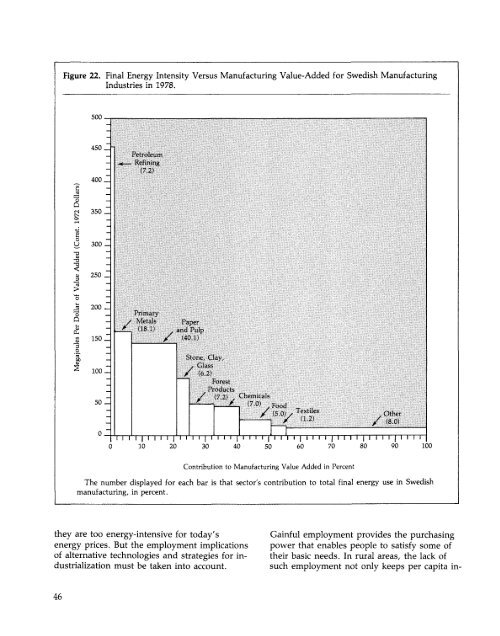ENERGY FOR A SUSTAINABLE WORLD - World Resources Institute
ENERGY FOR A SUSTAINABLE WORLD - World Resources Institute
ENERGY FOR A SUSTAINABLE WORLD - World Resources Institute
Create successful ePaper yourself
Turn your PDF publications into a flip-book with our unique Google optimized e-Paper software.
Figure 22. Final Energy Intensity Versus Manufacturing Value-Added for Swedish Manufacturing<br />
Industries in 1978.<br />
500.<br />
2<br />
re<br />
1<br />
450 _<br />
400 _<br />
350 _<br />
Petroleum<br />
- Refining<br />
(7.2)<br />
c<br />
U 300 .<br />
-a<br />
u<br />
250 _<br />
j« 200 _<br />
a<br />
150_|<br />
100 _<br />
50 _<br />
Primary<br />
Metals Paper<br />
(18.1) and Pulp<br />
X<br />
Stone, Clay,<br />
Glass<br />
/ (6.2)<br />
Forest<br />
Products<br />
/ (7 2) Chemicals<br />
' '<br />
l7 -°) .Food<br />
Other<br />
/ (8.0)<br />
1 I I I | I | II | I I I I | I I I I | I I I I | I I I I | I I I I | I I I I | I I I I | I I I I<br />
0 10 20 30 40 50 60 70 80 90 100<br />
Contribution to Manufacturing Value Added in Percent<br />
The number displayed for each bar is that sector's contribution to total final energy use in Swedish<br />
manufacturing, in percent.<br />
they are too energy-intensive for today's<br />
energy prices. But the employment implications<br />
of alternative technologies and strategies for industrialization<br />
must be taken into account.<br />
Gainful employment provides the purchasing<br />
power that enables people to satisfy some of<br />
their basic needs. In rural areas, the lack of<br />
such employment not only keeps per capita in-<br />
46

















